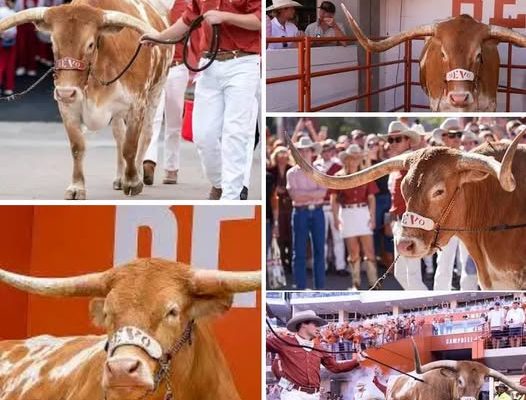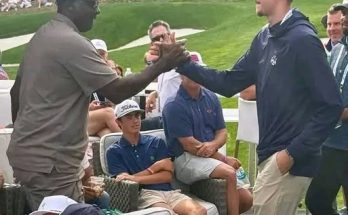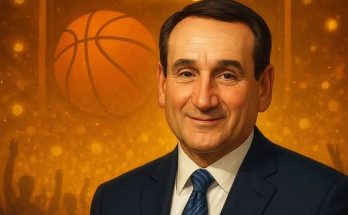There are mascots, and then there is Bevo. The iconic Texas Longhorn has long been a symbol of tradition, pride, and southern grit, but in the latest and perhaps most definitive ranking of college mascots, Bevo has claimed the ultimate crown. With a dominating mix of presence, personality, and pageantry, Bevo has been named the undisputed GOAT of the mascot world, toppling fierce rivals LSU’s Mike the Tiger and Georgia’s UGA in a showdown that has sparked heated debate across fanbases. Yet, for many, the result feels like a long time coming. Bevo’s win wasn’t simply about popularity; it was about embodying everything a mascot should represent—heritage, intimidation, charisma, and the kind of sideline swagger that makes opponents uneasy before the first whistle even blows.
In college football, mascots are more than just entertainment. They’re living, breathing emblems of identity, woven into the cultural fabric of their programs. Some walk on two legs in costumes, others prowl in cages, and a select few—like Bevo—are majestic, real-life animals whose presence alone can command a stadium. The Texas Longhorn has stood on the sidelines for over a century, his lineage dating back to the first Bevo in 1916, and through every era, he’s remained a powerful, stoic reminder of Texas pride. Bevo’s very silhouette is instantly recognizable, those massive horns stretching beyond the width of most players’ shoulder pads, a silent but unmistakable declaration: “We are Texas.”
It’s that sheer aura that helped Bevo edge out Mike the Tiger, LSU’s fierce live mascot, and UGA, Georgia’s beloved English Bulldog. Both have passionate fanbases and a rich history of their own. Mike, with his regal prowl and the roar that can echo in an opposing team’s head long before kickoff, has been an SEC symbol of dominance for decades. UGA, meanwhile, represents Southern charm and enduring loyalty, his wrinkled face and laid-back sideline demeanor a stark contrast to the chaos of the game. But Bevo’s victory in this mascot showdown wasn’t about dismissing their greatness—it was about surpassing it.
Part of Bevo’s rise to undisputed GOAT status comes from his ability to fuse intimidation with elegance. He’s an animal that can weigh more than a ton, yet he carries himself with calm control, unbothered by the roar of 100,000 fans or the blare of marching bands. His handlers, members of the Silver Spurs organization, train extensively to ensure that Bevo is not only comfortable in chaotic environments but thrives in them. While some mascots are there to whip up a crowd with antics, Bevo doesn’t need theatrics. He stands, watches, and reminds everyone in the stadium that Texas football carries a tradition as broad and unshakable as his horns.
The Lone Star swagger that propelled Bevo to the top was also about memorable moments that live in college football lore. The most famous incident came during the 2019 Sugar Bowl, when Bevo made headlines for lunging toward UGA on the sideline in a pre-game encounter. Handlers quickly pulled him back, but the image of a massive Longhorn making a spirited move toward a bulldog was etched into the minds of fans everywhere. It wasn’t malicious—just an undeniable statement of competitive fire. That moment became the perfect metaphor for Bevo: respectful of tradition but never backing down from a challenge.
Compared to Mike the Tiger, Bevo’s edge comes from his direct connection to the game-day atmosphere. Mike resides in a state-of-the-art habitat and is paraded in front of the stadium before kickoff, but he’s not pacing the sidelines in the thick of battle. Bevo, by contrast, is right there in the trenches—well, on the turf just behind them—when his team needs him. The proximity creates a visceral connection between Bevo, the players, and the fans, one that’s difficult for any other mascot to replicate. He’s not just a figurehead for the pregame ceremony; he’s a constant, grounding force from kickoff to the final whistle.
Then there’s UGA, the charming face of Georgia football. There’s no denying his cuteness factor, nor the emotional bond fans feel for each successive dog that takes on the mantle. But while UGA tugs at the heartstrings, Bevo commands respect. This mascot showdown wasn’t decided on adorableness—it was about the total package. Bevo’s combination of physical grandeur, tradition, and symbolic weight simply carries more impact in the high-stakes, high-intensity environment of major college football.
Bevo’s reign as GOAT also says something about the enduring appeal of live animal mascots in an era where many schools have shifted to costumed characters. There’s something raw and unfiltered about seeing a real Longhorn steer standing on the sideline, horns glinting in the stadium lights, unblinking under the weight of tens of thousands of eyes. It’s a living embodiment of the state of Texas itself—rugged, proud, and larger than life. No foam costume could ever replicate that effect.
This coronation also speaks to the work behind the scenes. Bevo isn’t just plucked from a ranch and thrown into the chaos of college football. His care, transportation, and training are handled with meticulous detail. The Silver Spurs, an honorary service organization at the University of Texas, have been tasked with his stewardship since 1937. They ensure that Bevo’s welfare is paramount, that he’s not overexposed to stress, and that every appearance is carefully managed for both safety and spectacle. That dedication not only keeps Bevo in top condition but enhances the legend—fans know they’re seeing a carefully preserved tradition, not a gimmick.
The GOAT title also resonates with Texas football’s broader cultural resurgence. In recent years, the Longhorns have been pushing to return to the upper echelon of the sport, and having the most dominant mascot in the game fits perfectly into that narrative. Bevo’s crown isn’t just about bragging rights; it’s a rallying point for the fanbase. In a sport where psychological edges matter, having the most respected mascot in the country sends a message before the teams even line up for the first snap.
Critics, of course, have their counterarguments. Some LSU faithful argue that Mike’s sheer power and exotic mystique should have secured him the top spot. After all, a tiger is a predator by nature, a symbol of ferocity that no steer can match in the wild. Georgia fans, meanwhile, point out that UGA’s global brand recognition and warm fan connection make him irreplaceable in the mascot hierarchy. Yet when you weigh all the elements—game-day impact, tradition, symbolism, and unforgettable moments—Bevo’s resume stands alone.
The cultural implications of this victory also extend beyond sports. Mascots are a form of storytelling, and Bevo tells a distinctly Texan story. He represents ranch life, independence, and the idea that size and strength are best paired with composure and dignity. His image is instantly tied to the burnt orange of Texas football, a visual shorthand for the program’s identity. For a state that prides itself on doing everything bigger, Bevo’s GOAT status feels like a natural extension of that ethos.
From a marketing standpoint, this recognition elevates Bevo into a new stratosphere. Merchandise sales, social media buzz, and national media appearances are likely to follow. The University of Texas has always understood the branding power of Bevo, but now that he’s officially been dubbed the greatest mascot of all time, the opportunities to leverage that status are endless. Imagine the possibilities—from ESPN features to viral TikToks—that could cement his place not just in sports culture, but in pop culture at large.
Still, perhaps the most important part of Bevo’s reign is what it means to the fans who’ve grown up with him. Generations of Longhorn supporters have brought their children to games and pointed toward the massive steer as a rite of passage. That moment of awe—the first time a young fan sees Bevo in person—is something that sticks for a lifetime. Now, knowing that their mascot isn’t just beloved but recognized as the best, those fans have one more reason to swell with pride.
In the end, Bevo’s coronation as the undisputed GOAT isn’t just about a title; it’s about legacy. It’s a celebration of over a century of tradition, of the countless handlers who have cared for him, of the games where his presence made the atmosphere electric. It’s about the way his silhouette against the Texas sunset has become as much a part of college football as the sound of a marching band or the sight of a goalpost. While Mike the Tiger and UGA remain legends in their own right, this moment belongs to Bevo—a symbol of Texas pride, a masterclass in sideline presence, and now, officially, the greatest mascot the sport has ever known.
With the crown firmly in place, Bevo will return to doing what he’s always done: standing tall, representing the University of Texas with dignity, and reminding everyone within sight of his horns that the Longhorns don’t just play football—they embody it. And if his rivals are plotting a comeback in the mascot rankings, they’d better be ready. Because Bevo’s not just wearing the crown; he’s setting the standard, and from the look in his calm, steady eyes, he has no intention of giving it up anytime soon.



